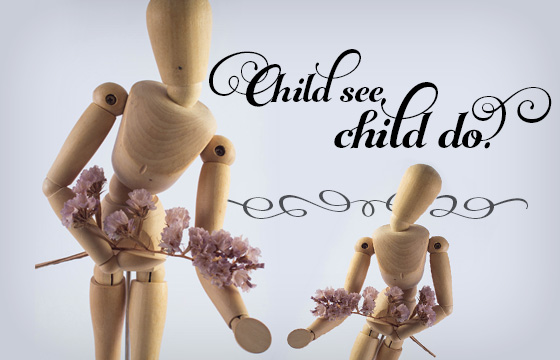Child see, child do.

I hate being shown up, especially when I’d been sure what I was doing was justified. But an imitating preschooler will demonstrate things with a clarity that adult introspection doesn’t touch.
I hadn’t been looking for a self-flagellation opportunity when I read an excerpt from a counsellor’s parenting book. I’d been trying to find a repair instruction for fixing a child with a broken temper control module. In my search, I read this:
“Sammy would get mad and run from the kindergarten class whenever he did not like what was going on. The teacher called his parents in for a conference. Sammy’s dad got frustrated with the conference and abruptly left the room. The teacher gained a better understanding of why Sammy behaved this way.”
Naturally, I overlaid the story onto my own family history to measure its relevance.
When Timmy’s mad at me, he won’t look at me. He’ll just about twist his head off in his efforts to wrench his face away. He’ll run to the couch and bury his face in a crevice of the cushions. Instructions of, “Timmy, look at me! Look at me!” only make him bury his face deeper.
This enrages me. I see no reason for such a rampant act of disobedience, except to antagonise me. It’s hard enough for me to control my own temper as I try explaining to him why I’d said No to something (because I recall how frustrating it is to be denied a reason), but when he won’t even look at me while I try to keep my voice level and explain, I feel the volcano in my chest erupt out the top of my head.
Then I’m furious. So I do what all the parenting books say you should do when you’re furious at your child and feel like you’re losing control: I remove myself from the situation to minimise the risk of actually slapping him across his stupid disobedient face.
So I spin around in place, to face the other way. I won’t look at him. Then, because that’s not enough to quell my chest volcano, I stride out of the room. Preferably to the other end of the house. (I don’t bury my face in couch cushions, but I’m taller than Timmy is, so that’s probably an ergonomic thing.) If he follows me before I’ve settled down, I pointedly don’t look at him. Sometimes I’ll even add, “I can’t look at you right now! I’m so angry! Leave me alone!”
It hadn’t occurred to me that Timmy’s refusal to look at me when he’s mad could be a learned behaviour. Which puts me in a bind. Because however I want him to act instead, is what I have to do for his imitation.
So how do I want him to act? I asked myself. Well…I want him to shut up and listen to me, until I’ve finished what I want to say. And it would help if he looked contrite. Or at least, if he didn’t frown and huff like an asthmatic steam train.
So how can I show that, then? When I feel anger, it usually comes on fast. Within seconds, my breathing will quicken and my fingertips will start shaking. (This might be from the claws trying to push their way through their protective epidermal sheath.) I can’t even imagine how to remain mature and well-behaved at that point. Not if I have to be looking at him at the same time.
Unless I have an immediate and motivating reason. Like, say, a social experiment for blog post research.
I took an educated guess that it wouldn’t be long for another opportunity to present itself. It would happen within a day, I was sure.
It happened within an hour, when Timmy came inside from our back yard and started running down the hall.
“What are you doing?” I asked.
“I have to change my shorts.”
“Why?”
“They’re wet.”
“That’s okay. That’s why you put them on—so you wouldn’t get muddy water all over your trousers.”
“They’re wet. I have to change.”
There are many scenarios in which having a dirt-conscious child is an asset. But when he’s gone outside in his new gumboots for the deliberate point of jumping in puddles with his brother, it’s no asset if he’s going to made the laundry pile grow every time he gets splashed.
Timmy was moving to resume his quest.
“Timmy, wait, Timmy, NO! TIMMY—” I yelled in desperate attempt to halt his plan.
He stopped. He frowned. His lips tightened. He was about to run away… I could just feel it…
Experiment, I thought. Just see what happens.
“Timmy,” I started in calm and incredibly difficult intonation, disguising my frustrated chest volcano. “If you put your shorts in the hamper, I’ll have to wash them. Then if you put your new shorts in the hamper as soon as they get wet and muddy, I’ll have to wash them, too. I don’t want to wash lots of shorts from one play session. That’s a lot of work for me. So wear those shorts until you’ve finished playing outside, please. Then you can take them off.”
“But they’re wet!”
“And that’s okay.”
“NO!” he yelled. “You’re not LISTENING!”
“TIMMY! I understand they are wet!” My voice had risen, and I pushed my chest volcano down again. “They’re meant to be wet. That will happen when you jump in puddles.”
Timmy looked conflicted, but he still stayed.
“You may change back into your trousers and stay inside, if you like,” I said. “Or you can go back outside in those shorts, and play.”
After a moment’s thought, he went back outside in his supposedly wet shorts.
Well, that was tedious, and…uninformative. I’d still yelled and gotten angry, so it seemed a contaminated experiment. I’d have to try again.
People over things, I would have to keep telling myself. People over things.
I get angry with him about material stuff, irrespective of motive—about unnecessary washing, about broken dishes, about dirty carpet. My introspective analysis shows me I find yelling at Timmy is acceptable behaviour if he’s committed some material offence, even it wasn’t done maliciously. This seems off, even to me.
People over things.
The next day Timmy tripped on the hearth and dropped a cake, along with the glass plate it was sitting on. The crack of the plate hitting the hearth resonated in my skull.
People over things.
I stayed where I was. I waited. (This good behaviour was probably encouraged by the fact I was videoing at the time, and I didn’t want my chest volcano digitally preserved.)
People over things.
“Oops,” Timmy finally said. “Sorry.”
People over things. Don’t ask about the plate first. “…Are you okay, Timmy?”
“Yup,” he said.
Well, this was looking better. There were no hostile tones. Nobody was getting worked up. Now that I’d ascertained the Person was fine, I could ask about the Thing. “How’s our cake?”
“The candles are falling off.”
And that was all. The cake was fine. As was the plate, to my surprise.
As I watched Timmy calmly retrieve candles and stuff them back into the cake, I realised three things:
1) My chest volcano was gone.
2) I hadn’t noticed the chest volcano ever since the moment I’d asked after Timmy, instead of the plate or the cake.
3) I’d remember this moment, and use it for volcano-taming purposes later. That could easily have gone the other way—me yelling over cake and carelessness, he responding in kind, and everybody being tense and wrought by the end, while refusing to look at each other.
The experiment isn’t complete. I need more cases, more data, to see verifiable patterns of influence. But for now, I see trends and potential, and I’d like to think that’s enough to motivate me in quashing my own chest volcano to show Timmy how to respond when feeling anger.
And if I don’t have time to cogitate my experiment history when in the heat of the moment, I can always fall back on the old adage:
Monkey see, monkey do.


26 Aug 2016
Success! And cake!
I don’t go volcano when I’m angry, I go glacier. Less shouting, but just as much withdrawal and rather more cold silence to follow. Any ideas on how to thaw an anger?
31 Aug 2016
I don’t have any deliberate thawing techniques. I just sit in the sun because it makes me feel better. It relaxes my muscles, and when my muscles lose their tension anger tends to go along with it, as a happy side effect.
02 Sep 2016
Sitting in the sun is probably not a goer in the Wellington region, alas, but if it’s muscle-relaxant that’s needed, there’s always the stash of super-dark Stress Chocolate.